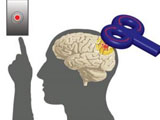|
|
TODAY.AZ / Weird / Interesting
Implanted electrodes loaded with drugs could monitor brain and treat It when necessary
10 June 2011 [11:48] - TODAY.AZ
 Electrode Implants Electrodes are already implanted in patient's brains to help monitor and mitigate the effects of several neurological conditions (in this case, Parkinson's). By giving them the ability to administer drugs, microelectrodes could also become first responders when the brain's chemistry or electrical signaling gets out of sync. Thomasbg via Wikimedia
Electrode Implants Electrodes are already implanted in patient's brains to help monitor and mitigate the effects of several neurological conditions (in this case, Parkinson's). By giving them the ability to administer drugs, microelectrodes could also become first responders when the brain's chemistry or electrical signaling gets out of sync. Thomasbg via WikimediaMicroelectrode arrays implanted in the brain monitor neurological conditions in living patients all the time, sometimes even influencing brain activity if it gets out of line. So, thought researchers at the University of Pittsburgh, why not load one up with drugs so it can deliver chemical therapy to problem sites immediately upon detecting an issue?
The team is developing a new polymer-coated electrode that can both monitor and treat a patient immediately, a capability that could be life-changing--or even life-saving--for those living with conditions like epilepsy. Their device is basically a microelectrode like any other, but it has been covered in a conductive polypyrrole film. Chambers in the film are loaded up with different drugs and neurotransmitters like dopamine or GABA.
Under certain electrical conditions, the polymer warps in certain ways, and when it does so its pharmaceutical payloads are released. By matching up certain tell-tale electrical signals associated with things like seizures to drugs that inhibit that activity, a microelectrode array can detect something like a seizure at its onset and begin delivering treatment straight to the brain immediately.
Once the polymer coating delivers its drugs, however, it is pretty much impossible to resupply it without basically replacing it--a procedure patients really don’t want to undergo too terribly often. The team is now looking at ways add drug reservoirs, possibly in the form of carbon nanotubes.
URL: http://www.today.az/news/interesting/87935.html
 Print version
Print version
Views: 1646
Connect with us. Get latest news and updates.
See Also
- 06 December 2024 [22:20]
Are scented candles harmful to health? - 23 November 2024 [14:11]
Magnitude 4.5 earthquake hits Azerbaijan's Lachin - 20 November 2024 [23:30]
Launch vehicle with prototype of Starship made its sixth test flight - 27 October 2024 [09:00]
Fuel prices expected to rise in Sweden - 24 October 2024 [19:14]
Turkiye strikes terror targets in Iraq and Syria - 23 October 2024 [23:46]
Kazakhstan supplied almost entire volume of oil planned for 2024 to Germany in 9 months - 23 October 2024 [22:17]
Taiwan reported passage of Chinese Navy aircraft carrier near island - 23 October 2024 [21:50]
Russia remains largest oil supplier to India - 16 October 2024 [17:54]
Gamesummit co-founder shares insights on future of gaming industry in Azerbaijan [EXCLUSIVE] - 12 October 2024 [18:27]
TikTok cuts jobs, turns to AI for content moderation
Most Popular
 More Armenians fly: the crisis of power in Canada
More Armenians fly: the crisis of power in Canada
 Azerbaijani delegation participates in internet governance forum in Riyadh
Azerbaijani delegation participates in internet governance forum in Riyadh
 Azerbaijan, Colombia Discuss Cooperation in Various Fields
Azerbaijan, Colombia Discuss Cooperation in Various Fields
 Armenian militant group threatens regional stability aligning with PKK/YPG in new ground
Armenian militant group threatens regional stability aligning with PKK/YPG in new ground
 Rubik Vardanyan surprises his own lawyers
Rubik Vardanyan surprises his own lawyers
 Azerbaijan's role in COP29 highlights growing global influence, says MEDIA Director
Azerbaijan's role in COP29 highlights growing global influence, says MEDIA Director
 Lapshin shows up, again collecting alms from naive Armenians
Lapshin shows up, again collecting alms from naive Armenians
